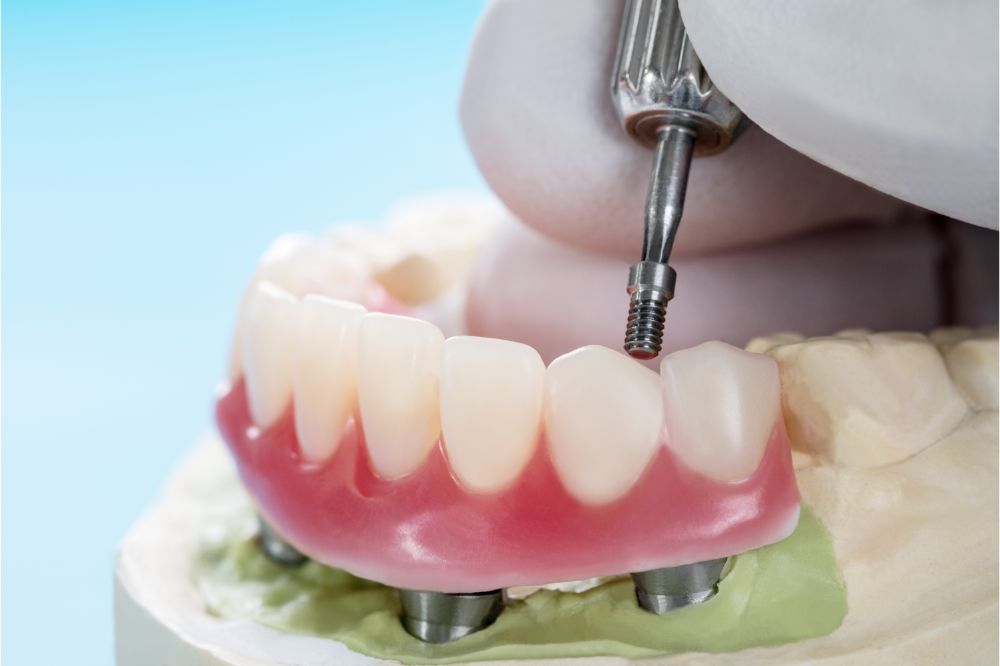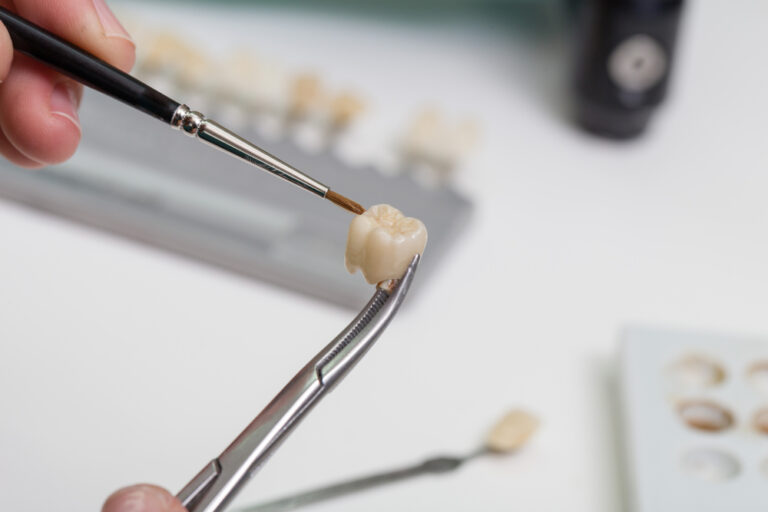As you know, dental implants can be costly, so the question is whether they are worth it. Most dentists agree they are an excellent investment in oral health in the long run. The first step is to determine whether you need an implant or denture.
Your dentist should recommend the necessary procedure and determine the price and possible additional costs. The final cost depends on various factors, and they can sometimes be lower than believed. So, let’s check how much are dental implants.
Dental implant price |
|
| Implant type | Price range |
| Mini dental implants | $500 to $1,000 per tooth |
| Standard dental implants | $3,000 to $5,800 |
| Clear-choice dental implants | $3,000 to $6,000 per tooth |
| Same-day dental implants | $5,000 to $8,000 per tooth |
| Multiple-teeth implant | $6,000 to $10,000 |
| Removable All-on-4® dental implants | $8,000 to $17,500 per arch |
| Fixed All-on-4® dental implants | $15,000 to $50,000 per arch |
| Full mouth implant | $60,000 to $90,000 |
How Much Do Dental Implants Cost?

The professional estimation is that an average, 45 to 64 years old American is missing five teeth. About 18% of those older than 65 have no natural teeth, typically because of gum diseases and injuries.
In such cases, dental implants are an excellent but pretty expensive solution. The best way to assess dental implant costs is by existing types. Let’s take a look.
1. Mini dental implants
Dentists use these temporary implants to stabilize dentures from the start, and are not intended for long-term use. However, they are necessary to enable the success of permanent implants.
The only situation for permanent use of this mini version is when a patient has not had enough bone for a standard implant. In any case, you should set aside approximately $500 to $1,000 per tooth.
2. Standard dental implants
This dental implant type created of titanium alloy includes a dental implant crown made of:
- Porcelain-fused-to-metal
- Layered zirconia
- Porcelain-filled composites
- max
- Full dental gold
- Full-contour zirconia
The price of this option depends on the crown material and ranges from $3,000 to $4,500 per tooth.
3. All-on-4® dental implants
This trademarked procedure includes 4 to 6 titanium dental implants to secure dentures to a top or bottom arch. You can recognize two varieties, including:
- Removable All-on-4® dental implants that cost about $8,000 to $20,000 per arch
- Fixed All-on-4® dental implants with a price of $15,000 to $50,000 per arch
The difference between them is in their removal possibility. For instance, you can put a removable model on and remove it as you wish, while only a dentist can manipulate fixed screw-retained dental implants. Remember that this option is not for all patients because of accompanying risks.
4. Same-day dental implants
The teeth-in-a-day procedure includes tooth extraction, bone grafting, and dental implant surgery on the same day. The first experiences suggest this unconventional process is successful, but dentists still report different results. If this procedure proves successful, it will be a real revolution in dental practice.
In comparison, a currently available conventional implant method requires a pause of approximately 4 to 6 months after the teeth extraction. You should set aside $5,000 to $8,000 per tooth if you are a fan of the latest achievements.
The Single-tooth Implant Cost

Be aware that you can’t buy only an implant (the post) since it is only the screw attached to the jawbone. It always goes with the crown and an abutment that connects it to the implant. So, you should consider the price of all three parts.
The single-tooth implant cost |
|
| Procedure | Price |
| The post | $1,500 to $3,000 |
| Abutment | $1,000 to $2,000 |
| Crown | $1,000 to $2,000 |
| Consultation and evaluation | $50 to $300 |
| X-Rays | $50 to $200 |
| Dental exams and X-rays | $200 to $450 |
| CT scans | $300 to $1,000 |
| Bone grafts | $200 to $3,200 |
| Tooth extraction | $100 to $700 |
| Sinus lift | $1,500 to $2,500 |
| Anesthesia | $50 to $200 |
The post (implant body)
Creating the post is the most invasive part of the implantation process since an oral surgeon needs to cut the gum and drill a hole into the bone to place it.
The goal is to insert the post deep enough to allow the jawbone growth over it until becoming one (osseointegration). This procedure requires experience and skill, making it the most expensive part. You should count on $1,500 to $3,000 per tooth.
Abutment
Immediately after completing the osseointegration process, the oral surgeon places the abutment to allow the crown attachment. In most cases, such a procedure is not too invasive but requires a local anesthetic. This part will cost you $1,000 to $2,000 on average.
Crown
It is necessary to wait approximately two weeks for the abutment to heal. Then, the dentist needs to use your mouth and healthy teeth impression before attaching the crown.
This process ensures a seamless look of the artificial tooth combined with natural ones. Since it is a job for a skilled laboratory technician, it is an expensive procedure, with the average cost ranging from $1,000 to $2,000. The final price depends on the crown type.
The Multiple Tooth and Full Mouth Implant Cost
Unfortunately, some situations require implanting more than one tooth. If you have such a case, you should consider one of two possibilities fitting your needs.
Multiple tooth implant
You can choose among a few options when replacing two or more teeth is necessary because they are next to each other. As expected, the price depends on the procedure you opp.
For instance, filling a gap between neighboring teeth includes two implants placed left and right of the missing tooth holding a bridge. Since it is less expensive than having three to four individual implants, you should set aside only $6,000 to $10,000.
If you need to replace more than four teeth, the estimated price ranges from $1,500 to $30,000. However, the procedure can sometimes cost up to $50,000, depending on the geographic region and missing teeth number.
Full mouth implant
You can count on the wide pricing range when replacing all teeth in your mouth because of various approaches to full-mouth tooth replacement.
Separately replacing each tooth is the most comfortable method for preserving existing healthy teeth. Unfortunately, this option is pricey and can cost you $60,000 to $90,000.
A more affordable option is to get implant-supported dentures (All-on-4). In this case, the dentist removes all remaining teeth and places two full false-teeth arches to replace the missing natural ones.
Total costs depend on the dental implant type and are $8,000 to $17,500 for removable All-on-4® dental implants and $15,000 to $50,000 for fixed ones. This price is per arch, so you should calculate double the price for both jaws.
Even though this sound much, the firm and secure full-mouth dental implants are convenient, permanent, and don’t require adhesives. The disadvantage of this method is the additional cost of existing teeth removal.
Other Costs Associated with Implants
Implanting the post, the abutment, and the crown are typically covered by one bill. However, you should also count on additional costs, including:
1. Consultation, evaluation, and X-rays
As expected, you need to go to the chosen dentist for consultation and evaluation before starting a procedure. This appointment typically costs $50 to $300.
Remember that you need jaw imaging before a dental implant receiving for additional teeth and bones’ health estimation. Therefore, you should add $50 to $200 to the final bill.
2. CT scans
It is not a routine procedure, and a dentist only needs these 3D cross-sectional images in complex situations. The price is $300 to $1,000.
3. Bone grafts
You need to set aside about $200 to $3,200 for this procedure when there is not enough bone in your jaw to support dental implants. It appears because of the following:
- Aging process
- When you have missing teeth for years
- In the case of untreated periodontal disease
- After the jaw physical trauma
- When genetic defect results in tooth abnormalities
In any of these cases, a surgeon needs to reinforce the natural bone with grafting material. If your case requires a sinus lift, it will cost you an additional $1,500 to $2,500. Plus, you need to pay $50 to $200 for anesthesia.
4. Tooth extraction
The necessity of extracting one or more teeth requires additional costs. This procedure costs $100 to $700, depending on the cause, like:
- Tooth decay
- Gum disease
- Tooth impaction
Ways to Save Money on Dental Implants
Interestingly, you can decrease your costs on dental implants in several ways, including:
- Dental tourism allows finishing the procedure abroad at a lower cost
- Check a list of participating dental schools since dental implants are less expensive there
- Talk to your dentist since some offices offer up to 40% discount when paying in cash
- Look for an AAID dentist since their experience may decrease costs by minimizing risks of implant failure
- Apply for a grant that covers some dental procedures, including dental implants
- Participating in a clinical trial allows inexpensive or free dental
- Look for an alternative financing option to reduce the credit interest
- Find a charitable organization that covers expenses for elderlies, people with disabilities, and domestic violence victims
- Consider alternatives, like a root canal with a crown, dental bridge, veneer, and denture
Summary
Dental implants are costly but last for a long and look natural. In most cases, one implant’s price is about a few thousand dollars, while you need to set aside up to $90,000 for the comprehensive full-mouth implant. Therefore, you should check your insurance and the expenses they cover before starting the procedure.






